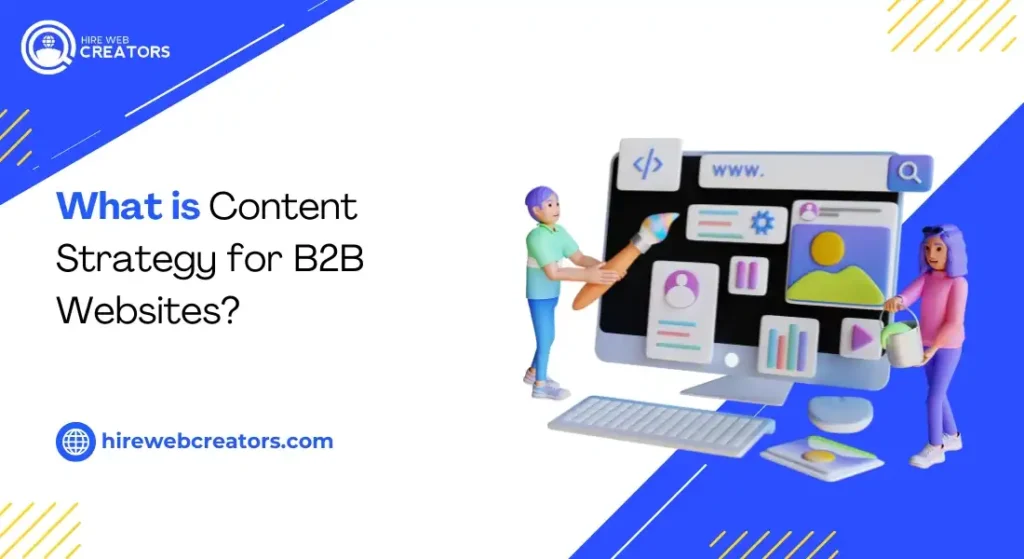
Content Strategy: 10 Proven Tips to Boost B2B Website Design
Achieve top-tier B2B website design with expert content strategy. Optimize content management to enhance user experience and results.
Designing B2B websites requires more than just an attractive layout; it demands a strategic approach to content management that aligns with business goals. In today’s competitive market, an effective content strategy is crucial for capturing attention, fostering engagement, and driving conversions. This blog delves into how a well-crafted content strategy can transform your B2B website, ensuring it not only meets but exceeds your organizational needs.
From defining key components of content strategy to implementing best practices in content creation and optimization, this guide provides actionable insights for designing high-performing B2B websites. Explore proven methods, tools, and case studies that highlight successful content management techniques, and learn how to integrate these strategies seamlessly into your web design process.
What is Content Strategy for B2B Websites?
A robust content strategy for B2B websites is fundamental to achieving business objectives and maximizing online presence. At its core, a content strategy involves planning, creating, managing, and measuring content in alignment with specific business goals. In the context of B2B, the content strategy must cater to a targeted audience, ensuring that every piece of content is designed to address the needs and pain points of other businesses rather than individual consumers. This strategy encompasses various elements such as content creation, distribution, and performance analysis, all crucial for enhancing the effectiveness of B2B websites.

Incorporating a content strategy into B2B website design involves a thorough understanding of the target audience and their content preferences. Effective strategies often include:
- Audience Analysis: Identifying and understanding the specific needs and challenges of the target B2B audience.
- Content Planning: Develop a content calendar that aligns with business goals and addresses key topics relevant to the audience.
- Content Creation: Crafting high-quality, engaging content that provides value and solves problems for other businesses.
- Content Distribution: Using appropriate channels to distribute content and reach the intended audience.
- Performance Measurement: Analyzing content effectiveness through metrics such as engagement rates and conversion rates.
A successful content strategy for B2B websites not only involves creating valuable content but also requires ongoing management and refinement. The strategy should be flexible to adapt to changing market trends and audience needs. By focusing on these components, businesses can ensure that their content effectively supports their objectives and drives meaningful engagement.
Moreover, implementing a content strategy involves integrating SEO best practices to enhance visibility and reach. In the B2B context, this means optimizing content with relevant keywords, including the primary keyword “content strategy B2B,” to improve search engine rankings and attract the right audience. Regularly updating and optimizing content ensures that the website remains relevant and continues to meet the evolving needs of businesses.
Why is Content Management Crucial for B2B Sites?
Content management is a critical component of B2B websites, playing a key role in how effectively a business communicates with its audience. Effective content management ensures that content is organized, accessible, and aligned with the overall content strategy. For B2B sites, managing content efficiently means maintaining a consistent brand voice and delivering valuable information that meets the needs of other businesses. This involves everything from the initial creation of content to its ongoing updates and maintenance.
Managing content well on B2B websites involves several key practices:
- Centralized Content Storage: Ensuring that all content is stored in a centralized system for easy access and management.
- Content Organization: Structuring content in a way that makes it easy for users to find relevant information quickly.
- Content Updates: Regularly updating content to keep it current and relevant to the target audience.
- Content Access Control: Implementing permissions to control who can create, edit, or publish content.
Content management is vital in B2B environments because it impacts how businesses present their value propositions and engage with their audience. A well-managed content system allows for the seamless integration of the content strategy into the website, ensuring that all content supports business objectives and addresses the needs of other businesses effectively. By focusing on efficient content management, B2B companies can enhance user experience and maintain a professional image.
Effective content management also involves using tools and technologies that facilitate content creation, editing, and publication. In the B2B context, content management systems (CMS) play a crucial role in streamlining these processes. Choosing the right CMS ensures that content is managed effectively and integrates smoothly with the overall content strategy. Implementing best practices in content management helps B2B websites deliver consistent, high-quality content that engages the target audience and supports business growth.
What Are the Key Components of a B2B Content Strategy?
A B2B content strategy is built on several key components that work together to achieve business goals. The foundation of a successful content strategy involves understanding the target audience, setting clear objectives, and developing a plan for content creation and distribution. These elements are essential for ensuring that the content aligns with business goals and effectively addresses the needs of other businesses.

Key components of a B2B content strategy include:
- Audience Research: Identifying and analyzing the specific needs, challenges, and preferences of the target B2B audience.
- Content Goals: Setting measurable objectives that the content should achieve, such as increasing brand awareness or generating leads.
- Content Types: Determining the types of content that will resonate with the audience, such as blog posts, whitepapers, or case studies.
- Content Distribution: Planning how and where content will be distributed to reach the target audience effectively.
- Performance Metrics: Establishing metrics to measure the success of the content strategy, such as engagement rates and conversion rates.
Each component of the content strategy must work together to support the overall goals of the B2B website. A well-defined strategy ensures that content is created and managed in a way that maximizes its impact and effectiveness. By focusing on these key components, businesses can develop a comprehensive content strategy that drives results and supports their objectives.
Integrating the primary keyword “content strategy B2B” into each component of the strategy helps ensure that content is optimized for search engines and relevant to the target audience. Regularly reviewing and adjusting the content strategy based on performance data allows businesses to stay aligned with their goals and continually improve their content efforts. A strategic approach to content creation and management is crucial for achieving success in the competitive B2B landscape.
How to Align Content with B2B Business Goals?
Aligning content with B2B business goals is crucial for ensuring that every piece of content supports the overall objectives of the company. A well-aligned content strategy helps to drive business results by ensuring that content efforts are focused on meeting specific goals, such as increasing leads, driving traffic, or enhancing brand visibility. Achieving this alignment involves understanding the business’s key objectives and tailoring content to support those objectives.
To align content with B2B business goals, consider the following steps:
- Define Business Objectives: Clearly outline the key goals of the business, such as generating leads or increasing sales.
- Identify Target Audience: Understand who the content is intended for and what their needs and pain points are.
- Create Relevant Content: Develop content that addresses the needs of the target audience while supporting business objectives.
- Measure Impact: Use analytics to track how well content is performing about business goals.
Ensuring that content is aligned with B2B business goals helps to maximize its effectiveness and drive meaningful results. By focusing on content that supports business objectives, companies can improve their chances of achieving their goals and generating a positive return on investment. Regularly reviewing content performance and making adjustments as needed ensures that content remains relevant and impactful.
Incorporating the primary keyword “content strategy B2B” into content alignment efforts ensures that the content is optimized for search engines and effectively reaches the target audience. By maintaining a strategic focus on business goals, B2B companies can create content that not only engages their audience but also contributes to their overall success.
What Role Does User Experience Play in B2B Content Management?
User experience (UX) plays a significant role in B2B content management, influencing how visitors interact with a website and engage with its content. A positive UX ensures that users can easily find and access the information they need, leading to higher satisfaction and better overall results. In the context of B2B websites, effective content management must prioritize UX to enhance usability and support business objectives.
Key aspects of UX in B2B content management include:
- Navigation: Ensuring that the website is easy to navigate, with clear menus and intuitive pathways to content.
- Design: Creating a visually appealing design that supports content readability and engagement.
- Responsiveness: Ensuring that content is accessible and performs well on all devices, including mobile.
- Load Speed: Optimizing content and website performance to reduce load times and improve user experience.
A focus on UX in B2B content management helps to improve user satisfaction and increase the likelihood of achieving business goals. By designing a user-friendly website and managing content effectively, businesses can create a positive experience that encourages engagement and drives results. Regularly evaluating and enhancing UX ensures that the website remains effective in meeting the needs of the target audience.
Using the primary keyword “content strategy B2B” in UX considerations helps to ensure that content remains relevant and optimized for search engines. Prioritizing UX in content management efforts contributes to a better overall experience for users and supports the success of the B2B website.
How to Develop a Content Calendar for B2B Websites?
Developing a content calendar is an essential step in managing content for B2B websites. A content calendar helps to plan, organize, and schedule content creation and publication activities. This tool is crucial for ensuring that content is delivered consistently and aligns with the overall content strategy. For B2B sites, a well-organized content calendar supports timely and relevant content that meets the needs of other businesses.
Steps to develop an effective content calendar include:
- Define Content Goals: Establish what the content should achieve, such as increasing engagement or generating leads.
- Identify Key Topics: Determine the topics and themes that are relevant to the target B2B audience.
- Plan Content Types: Decide on the types of content to create, such as blog posts, whitepapers, or infographics.
- Schedule Content: Create a timeline for content creation and publication, ensuring that deadlines are met.
- Review and Adjust: Regularly review the content calendar to make adjustments based on performance data and changing priorities.
A well-structured content calendar helps B2B websites manage content creation efficiently and ensures that content is delivered in a timely manner. By aligning the calendar with the primary keyword “content strategy B2B,” businesses can optimize their content efforts and improve search engine visibility. Effective content planning and scheduling contribute to the overall success of the B2B content strategy.
What Are the Best Practices for Content Creation and Curation?
Content creation and curation are fundamental aspects of a B2B content strategy. Adhering to best practices in these areas ensures that content is high-quality, relevant, and engaging for the target audience. Effective content creation and curation involve understanding the audience’s needs, maintaining consistency, and leveraging various content formats to maximize impact.

Best practices for content creation and curation include:
- Understand Audience Needs: Create content that addresses the specific challenges and interests of the B2B audience.
- Maintain Consistency: Ensure that content aligns with the brand voice and messaging across all channels.
- Utilize Various Formats: Incorporate different content formats, such as articles, videos, and infographics, to engage a diverse audience.
- Curate Relevant Content: Share valuable content from other sources that complements your own and provide additional value to your audience.
Implementing these best practices helps B2B websites deliver content that is both engaging and valuable. By focusing on the primary keyword “content strategy B2B” in content creation and curation efforts, businesses can enhance their content’s relevance and effectiveness. Consistent, high-quality content supports the overall content strategy and contributes to achieving business goals.
How to Optimize Content for SEO in a B2B Context?
Optimizing content for SEO is crucial for enhancing visibility and driving traffic to B2B websites. Effective SEO ensures that content is discoverable by search engines and reaches the intended audience. In the B2B context, optimizing content involves using relevant keywords, creating high-quality content, and implementing SEO best practices to improve search engine rankings.
Key SEO optimization strategies for B2B content include:
- Keyword Research: Identify and use relevant keywords, including “content strategy B2B,” to improve search engine rankings.
- On-Page SEO: Optimize content elements such as titles, meta descriptions, and headers to align with SEO best practices.
- Quality Content: Create high-quality, valuable content that addresses the needs of the target B2B audience.
- Backlink Building: Develop a strategy for acquiring high-quality backlinks to enhance content authority and search rankings.
Optimizing B2B content for SEO involves ongoing efforts to ensure that content remains relevant and effective in achieving search engine visibility. By focusing on SEO best practices and incorporating the primary keyword “content strategy B2B,” businesses can improve their content’s discoverability and drive more targeted traffic to their website.
What Tools and Technologies Aid in B2B Content Management?
Utilizing the right tools and technologies is essential for effective B2B content management. These tools help streamline content creation, organization, and distribution processes, making it easier to implement and manage a content strategy. For B2B websites, leveraging technology can enhance content management efforts and improve overall efficiency.
Key tools and technologies for B2B content management include:
- Content Management Systems (CMS): Platforms like WordPress and Drupal that facilitate content creation, editing, and publishing.
- Content Scheduling Tools: Tools such as Hootsuite and Buffer help plan and schedule content distribution across various channels.
- Analytics Platforms: Tools like Google Analytics that provide insights into content performance and user engagement.
- SEO Tools: Software such as SEMrush and Ahrefs that assist with keyword research and SEO optimization.
By integrating these tools into content management practices, B2B websites can enhance their content strategy and improve overall effectiveness. Incorporating the primary keyword “content strategy B2B” into the content management process ensures that content remains aligned with business goals and optimized for search engines. Utilizing technology effectively supports the successful implementation of a B2B content strategy.
How to Measure the Success of B2B Content Strategy?
Measuring the success of a B2B content strategy is essential for understanding its impact and effectiveness. Evaluating content performance helps businesses determine whether their content efforts are achieving desired outcomes and provides insights for future improvements. Key metrics and methods for measuring success include tracking engagement, conversions, and overall ROI.

To measure the success of a B2B content strategy, consider the following:
- Engagement Metrics: Monitor metrics such as page views, time on page, and social shares to assess how well content resonates with the audience.
- Conversion Rates: Track the number of leads or sales generated from content to evaluate its effectiveness in driving business results.
- ROI Analysis: Calculate the return on investment by comparing content costs with the generated revenue or other business benefits.
- Feedback and Surveys: Collect feedback from users to gain insights into content effectiveness and areas for improvement.
By focusing on these metrics and incorporating the primary keyword “content strategy B2B” into performance evaluations, businesses can gain a comprehensive understanding of their content strategy’s success. Regularly analyzing content performance helps identify strengths and areas for improvement, ensuring that the content strategy remains effective and aligned with business goals.
How to Improve Content Strategy Based on Performance Data?
Improving a content strategy based on performance data involves analyzing metrics and making data-driven adjustments to enhance content effectiveness. Regular evaluation of content performance provides valuable insights into what works and what doesn’t, allowing businesses to refine their strategy and achieve better results.
To improve a B2B content strategy based on performance data, follow these steps:
- Analyze Performance Metrics: Review data on engagement, conversions, and other key metrics to identify trends and areas for improvement.
- Adjust Content Focus: Modify content topics and formats based on what resonates most with the target audience.
- Optimize Distribution Channels: Refine content distribution strategies to reach the audience more effectively.
- Update Content: Refresh and optimize existing content to ensure it remains relevant and engaging.
Incorporating the primary keyword “content strategy B2B” into content updates and optimizations helps ensure that changes align with SEO goals and audience needs. Data-driven improvements, combined with professional web development services, contribute to a more effective content strategy that supports business objectives and drives better results. Regularly reviewing and adjusting the strategy based on performance data, in tandem with refining web development services, ensures continued success and alignment with evolving business goals.
What Are Some Successful B2B Content Management Case Studies?
Examining successful B2B content management case studies provides valuable insights into how different companies have effectively implemented their content strategies. These case studies illustrate practical applications, strategies, and outcomes that can serve as models for other businesses aiming to enhance their content management practices.
Key examples include:
- HubSpot: HubSpot’s content strategy focuses on delivering valuable and educational content to its audience. They use a mix of blog posts, eBooks, webinars, and interactive content to engage users and drive leads. HubSpot’s success in content management is evident in its ability to generate high-quality leads and build strong brand authority.
- Salesforce: Salesforce effectively integrates content management with its CRM solutions. Their content strategy includes comprehensive resources like case studies, whitepapers, and how-to guides. This approach not only showcases their expertise but also provides actionable insights that help potential clients make informed decisions.
- Adobe: Adobe’s content management success lies in its use of visual storytelling and interactive content. By creating engaging case studies, success stories, and product demos, Adobe effectively captures its audience’s attention and demonstrates the value of its creative software solutions.
These case studies highlight how a well-implemented content strategy can drive engagement, generate leads, and enhance brand credibility. Integrating diverse content formats and maintaining a focus on delivering value are crucial elements of successful B2B content management.
How to Integrate Content Strategy with Other Marketing Efforts?
Integrating content strategy with other marketing efforts ensures a cohesive approach to reaching and engaging the target audience. A unified strategy amplifies the impact of individual marketing initiatives and aligns them with overall business objectives.

To achieve successful integration, consider the following steps:
- Align Content with Marketing Goals: Ensure that content objectives are aligned with broader marketing goals, such as brand awareness, lead generation, and customer retention. This alignment helps in creating content that supports and enhances other marketing efforts.
- Utilize Cross-Channel Marketing: Distribute content across various channels, including social media, email marketing, and paid advertising. Consistent messaging across channels reinforces the content’s impact and reaches a wider audience.
- Leverage Data and Analytics: Use data from different marketing efforts to inform content creation and distribution. Analyzing performance metrics helps in understanding what content resonates with the audience and how it contributes to overall marketing success.
- Collaborate with Other Teams: Foster collaboration between content creators, SEO specialists, social media managers, and other marketing professionals. This collaboration ensures that content is optimized for different platforms and supports various marketing strategies.
Integrating content strategy with other marketing efforts creates a unified and effective approach to reaching and engaging the target audience. By aligning content with marketing goals and leveraging data, businesses can enhance their overall marketing impact.
What Future Trends Should You Consider for B2B Content Management?
Staying ahead of emerging trends is crucial for maintaining an effective B2B content management strategy. Future trends in content management are shaping how businesses engage with their audience and leverage content for growth.
Key trends to consider include:
- AI and Automation: Artificial intelligence and automation are transforming content creation and management. AI tools can assist with content generation, personalization, and data analysis, making content strategies more efficient and effective.
- Interactive Content: Interactive content, such as quizzes, polls, and interactive infographics, is gaining popularity. This type of content engages users more deeply and provides valuable insights into their preferences and behaviors.
- Content Personalization: Personalizing content based on user data and behavior enhances relevance and engagement. Advanced segmentation and targeting techniques allow businesses to deliver tailored content that resonates with individual users.
- Video Content: Video content continues to grow in importance, with live streaming and short-form videos becoming increasingly popular. Incorporating video into content strategies can boost engagement and provide dynamic ways to communicate with the audience.
- Voice Search Optimization: As voice search becomes more prevalent, optimizing content for voice queries is essential. This includes focusing on natural language and providing concise, informative answers to common questions.
Embracing these future trends in B2B content management ensures that businesses remain competitive and effectively engage their audience. By staying informed about emerging technologies and evolving user preferences, companies can adapt their content strategies to meet changing demands and achieve long-term success.
In conclusion, Designing B2B websites with a focus on effective content management and strategy is crucial for achieving business success in today’s competitive market. By implementing a well-thought-out content strategy B2B, businesses can ensure that their content not only resonates with their target audience but also aligns with their broader business objectives. A well-executed content strategy enhances user engagement, drives qualified leads, and supports brand authority, ultimately contributing to a stronger market presence and better business outcomes.
To stay ahead in the B2B space, it is essential to continually refine and optimize your content management practices based on performance data and evolving industry trends. Leveraging the right tools and technologies, understanding audience needs, and maintaining a strategic focus will help in creating content that delivers value and drives results. As B2B businesses navigate the complexities of digital content, embracing a robust content strategy B2B will position them for long-term success and sustained growth.
